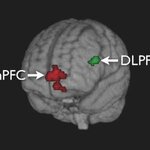Neuroscience

Monkeys playing a game similar to "Let's Make A Deal" have revealed that their brains register missed opportunities and learn from their mistakes.
The researchers watched individual neurons in a region of the brain called the anterior cingulate cortex (ACC) that monitors the consequences of actions and mediates resulting changes in behavior. The monkeys were making choices that resulted in different amounts of juice as a reward.
Their task was like the TV show "Let's Make a Deal" with the experimenters offering monkeys choices from an array of hidden rewards. During each trial,…

As if you need another reason for parental guilt, a new article in Bioscience Hypotheses speculates that our feelings could impact our reproduction and affect our children.
Dr Alberto Halabe Bucay of Research Center Halabe and Darwich, Mexico, suggests that a wide range of chemicals that our brain generates when we are in different moods could affect 'germ cells' (eggs and sperm), the cells that ultimately produce the next generation. Such natural chemicals could affect the way that specific genes are expressed in the germ cells, and hence how a child develops.
In his article Halabe …

This blog entry is about one of the most interesting discoveries of the 90's in Neuroscience -- Mirror Neurons -- and a recent research paper that adds to their intrigue.
Mirror neurons are found in the premotor cortex, and what has made them so interesting is that they fire both when the individual performs a goal-directed action and when they watch someone else perform the same action. It is as if the mirror neurons encode an understanding about the intentions of someone else. For example, when my husband reaches for his coffee cup I understand that he intends to take a drink before he…

When you're on a diet, deciding to skip your favorite calorie-laden foods and eat something healthier takes a whole lot of self-control--an ability that seems to come easier to some of us than others. Now, scientists from the California Institute of Technology (Caltech) have uncovered differences in the brains of people who are able to exercise self-control versus those who find it almost impossible.
The key? While everyone uses the same single area of the brain to make these sorts of value-laden decisions, a second brain region modulates the activity of the first region in people with good…
The Alzheimer’s Project
Alzheimer's disease is the 6th leading cause of death in US. Currently, there are approximately 5 million AD patients in US and the total direct/indirect cost is $148 billion/year. With the aging population of 77 million baby-boomers, the number of patients are expected to be more than 14 million by year 2050 and the cost is expected to exceed $1 trillion/year. Thus, we have an unprecedented socio-economical challenge looming ahead of us, which not everyone (including scientists as well as laypersons) is fully aware of.
In this context, HBO is…

Research presented Thursday at the European Congress on Obesity says scheduling more physical education time in schools does not mean children will increase their activity levels; those who got lots of timetabled exercise at school compensated by doing less at home while those who got little at school made up for it by being more active at home.
They propose it's not the environment that drives physical activity levels in children, but some form of central control in the brain similar to appetite – an 'activitystat.'
Except appetite is learned by practice too. People who eat a lot get…

A new study from Northwestern University shows what many mothers already know: their babies are a lot smarter than others may realize.
Though only five months old, the study's cuties indicated through their curious stares that they could differentiate water in a glass from solid blue material that looked very much like water in a similar glass.
The finding that infants can distinguish between solids and liquids at such an early age builds upon a growing body of research that strongly suggests that babies are not blank slates who primarily depend on others for acquiring knowledge. That's…

Toddlers with autism appear more likely to have an enlarged amygdala, a brain area associated with numerous functions, including the processing of faces and emotion, according to a report in the May issue of Archives of General Psychiatry.
In addition, this brain abnormality appears to be associated with the ability to share attention with others, a fundamental ability thought to predict later social and language function in children with autism.
“Autism is a complex neurodevelopmental disorder likely involving multiple brain systems,” the authors write as background information in the…

How many times have you wondered where did I leave my keys? Activity in your hippocampus and medial temporal lobes encodes the answer.A new study using high resolution brain imaging has shown that the encoding of memories involves the precise pattern of activity of a very large number of neurons in the human hippocampus. The hippocampus and surround medial temporal lobes are important parts of the brain for our ability to navigate, form and recall memories, and imagine future experience. This study found that the pattern of activity can be read like a map to accurately “…

Infants who receive the pneumococcal conjugate vaccine (PCV) following the combination vaccine for diphtheria, polio, tetanus, pertussis and Haemophilus influenzae type b (DPTaP-Hib vaccine) appear to experience less pain than those who are immunized in the opposite order, according to a report in the May issue of Archives of Pediatrics&Adolescent Medicine, a theme issue on vaccines.
Injections are the most painful common medical procedure conducted in childhood, according to background information in the article.
"Multiple injections are routinely administered during a single visit…